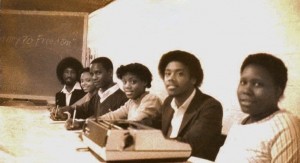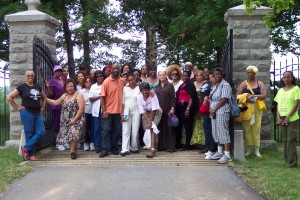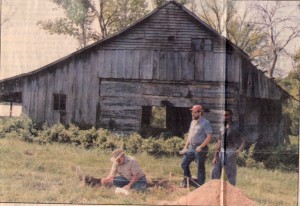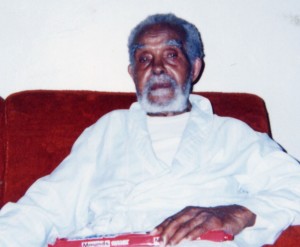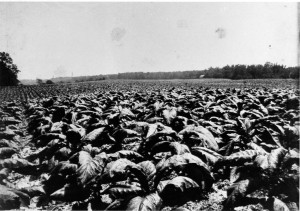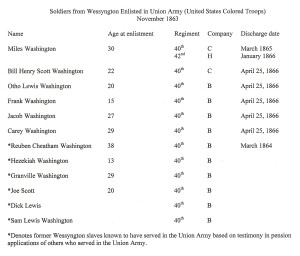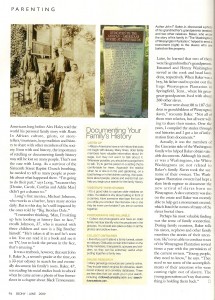Recently while going through some old photographs, I ran across this one taken with childhood friends Wanda Gardner, Drextel Bowling, Teresa Gardner, Charles Gardner and Kim Bradley. The photo was taken in 1981 at Greater South Baptist Church during a Black history lesson. I was quite surprised when I noticed the blackboard behind me had part of the subtitle to my book Journey to Freedom in the background nearly thirty years before the book was published. My publishers at Atria Books, a Division of Simon & Schuster selected the subtitle for The Washingtons of Wessyngton Plantation.
Posts Tagged ‘black history’
30 Year Old Photo Foretells Subtitle of The Washingtons of Wessyngton Plantation
Tuesday, July 26th, 2011National Black Arts Festival Study Group Walks in Footsteps of Baker’s Ancestors on Wessyngton Plantation
Sunday, June 13th, 2010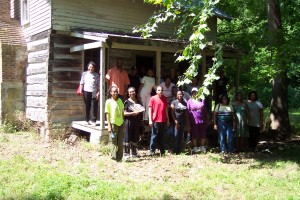
In addition to touring the grounds surrounding the Wessyngton mansion, National Black Arts Festival members and guests walked in the footsteps of Baker’s ancestor in the slave cabin area of the plantation. The group went inside a restored slave cabin built ca. 1830. In 1860, there were 274 enslaved African Americans on the plantation, housed in forty log cabins. At the onset of the Civil War, Wessyngton held the largest African American population in the state of Tennessee and was the largest tobacco producer in America.
National Black Arts Study Group at Wessyngton Plantation
Sunday, June 13th, 2010Today I had the honor of conducting a study group tour of Wessyngton Plantation for Dr. Collette Hopkins, Director of the National Black Arts Festival of Atlanta, along with a number of her colleagues and distinguished guest. The tour included a visit to the Wessyngton mansion, Washington family cemetery, and a former slave cabin. Participants were told about the lives of enslaved African Americans on the largest tobacco plantation in America and walked in their footsteps.
The above photo was taken at the entrance gate to Wessyngton Plantation where I was told as a small child by my grandfather that was where my ancestors came from. The interest in my family’s history led me on a thirty year journey of discovery and the writing of The Washingtons of Wessyngton Plantation: Stories of My Family’s Journey to Freedom.
Author Shows History Begins at Home
Thursday, March 4th, 2010The Washingtons of Wessyngton Plantation reviewed in Nashville City Paper by Todd Dills. Click here to see review.
Washingtons of Wessyngton Plantation: Stories of My Family’s Journey to Freedom – Resource for Educators and Teachers
Tuesday, February 9th, 2010The Washingtons of Wessyngton Plantation: Stories of My Family’s Journey to Freedom has been released in trade paperback and is an excellent resource for teachers and educators. The book chronicles the African American experience from slavery to freedom. It has more than 100 photographs and portraits of African Americans who were once enslaved. The book covers many aspects of plantation slavery, the Civil War, Reconstruction, Jim Crow, Genealogy, and DNA testing.
http://books.simonandschuster.net/Washingtons-of-Wessyngton-Plantation/John-F-Baker-Jr/9781416567417
Slave Descendant Walks in Ancestors’ Footsteps on Wessyngton Plantation
Monday, November 2nd, 2009In 1991, I had an opportunity that few historians or genealogists ever have; to literally walk in your ancestors’ footsteps. In 1989 I was approached by the president of the Bloomington-Normal black history Project and director of the Midwestern archaeological research Center, about the potential investigations of the salve cabin area on Wessyngton Plantation to get an interpretation of slave life there. Similar digs have been conducted at the Hermitage, Mt. Vernon, and Monticello.
The actual digging at Wessyngton did not start until 1991. The thought of actually walking in my ancestors’ footsteps and holding objects they used in their everyday lives one hundred years earlier was surreal to me. Three sections of the slave cabin area were selected for exploration. One site was where the cabin of my great-great-grandparents Emanuel and Henny Washington once stood.
The dig yielded fragments of pottery and dishes used by my ancestors as well as coins and arrowheads made by Native Americans.
The photograph above shows the site of the archaeological dig on Wessyngton Plantation where my ancestors once lived.
Oral History Key to Tracing African American Roots
Sunday, October 18th, 2009In more than thirty years of researching my ancestry and the lives of African Americans enslaved on Wessyngton Plantation, I have had the honor of interviewing more than twenty individuals whose parents or grandparents lived on the plantation. These individuals ranged in age from eighty to 107 years old.
Although I found hundreds of documents about my ancestors from plantation records written by the owners of Wessyngton, I learned many personal things about my ancestors from conducting interviews with elder family members.
In 1994, I visited my cousin Joseph Washington 1895-2002 (pictured above) at his home in Mansfield, Ohio on his one hundred second birthday. As a child Joseph lived next door to my great-great-grandparents Emanuel and Henny Washington who were born at Wessyngton in the early 1800s. He related many stories about them to me including ghost stories that my great-great-grandfather used to tell all the children on the plantation and songs he used to sing. Joseph told me what life was like on the plantation when he grew up there and how many people on the plantation were related to one another.
Oral history is a vital key to tracing African American genealogy and provides many details about our ancestors that can’t be found in records.
Slave Labor on Southern Plantations
Wednesday, October 7th, 2009
Slaves toiled endlessly, clearing land, plowing fields, raising livestock, erecting buildings, and planting crops to transform frontier landscapes into lavish plantations.
The enslaved population on Wessyngton Plantation primarily produced tobacco, which was very labor intensive. In 1860, 250,000 pounds of tobacco was produced on Wessyngton making it the largest producer of tobacco in the United States and the second largest in the world.
How Can We Honor Our Ancestors on Memorial Day?
Monday, May 18th, 2009On Memorial Day, we need to take a moment to tell our children about their ancestors who fought for freedom and America. During the Civil War, our ancestors fled slavery and the plantations and joined the Union Army to fight for freedom. We must never forget the sacrifices of our ancestors that we might enjoy freedom today.
My Story in June Issue of Ebony
Monday, May 11th, 2009Check out my story in this month’s Ebony. “Telling our Stories: Relaying family history to children can keep our heritage alive.” On page 94, Shirley Henderson describes my story. A photograph of my ancestors and the Wessyngton Plantation slave cemetery memorial illustrate the article.
